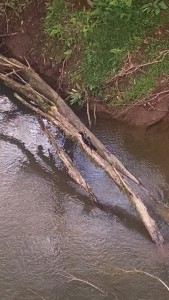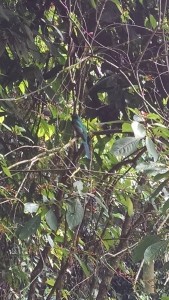Many different birds can be found in Costa Rica, and it is paradise for bird watchers. Forsyth and Miyata (1984) explained that the patch of lowland rainforest can hold about 200 different bird species. Bird watchers will have a good chance of spotting a beautiful tropical bird in Costa Rica, especially for those Costa Rican endemic species (birds that are native to Costa Rica, only, they cannot be found anywhere else). Birds are more than just looking colorful or making pretty sound, they are great at spreading seeds for rainforest’s plants and keeping insect population under the control (Karp and Daily, 2014). Imagine if there were no birds, the backyard garden would be overrun by insects.
In simpler terms, birds are amazing. And pretty.
So, for the first week of our field course in Costa Rica, we were to learn one of four methodologies for a mini-research of the week. Obviously, from my thinking of birds being amazing creatures, I picked spot census methodology to count birds for species richness at La Selva, to assess bird species richness across three different habitats. It is important to remember that it is more important to count species, rather than counting number of individuals.
The result of our mini- result is… there was no significant difference. We had to drop our secondary forest because we were not able to do three census due to the rain, therefore there is not enough data on that habitat. We compared arboretum and human-developed land only and our statistical analysis showed that both habitats, both very different from each other, don’t have any significant difference. It means that both habitats have same amount of species richness.
I thought that was interesting because birds are extremely sensitive to disturbances, and based on intermediate disturbance hypothesis, Human-developed land should have less species because it is highly disturbed habitat than habitats that get disturbed less often (aka arboretum).
That brings more questions for us to think about! Is it because our data sets are incomplete, is it because of type of plants found in either habitats, is it because of many different variables we faced in our statistical analysis, or is it just because we aren’t good at spotting birds?
With questions bouncing around in my head, I wrote a research proposal asking does the species richness of Costa Rican birds change as the rainforest matures from an open pasture into a mature rainforest at Las Cruces, our next and last research station? Based on intermediate disturbance hypothesis, I would expect to see the widest species richness of bird to be located in a secondary forest habitat at Las Cruces because it is a habitat with intermediate amount of disturbance compared to open pasture (high disturbance) and primary forest (least disturbance).
Anhinga, Anhinga anhinga, on the lower branch of the log.
Violaceous Trogon, Trogon violaceus, right in the middle of the picture.
Works cited:
Forsyth, Adrian and Miyata, Ken. Tropical Nature: Life and Death in the Rain Forests of Central and South America. Simon and Schuster: New York, 1984. Print.
Karp, Daniel S. and Gretchen C. Daily. “Cascading effects of insectivorous birds and bats in tropical coffee plantations.” Ecology. 95.4. (2014):1065-1074.

